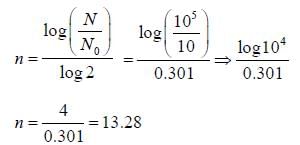Microbiology MCQ 1 - Biotechnology Engineering (BT) MCQ
21 Questions MCQ Test Mock Test Series of IIT JAM Biotechnology 2026 - Microbiology MCQ 1
Which amongst the following is an example of monotrichous bacteria?
If a bacterial culture has a doubling time of 50 minutes then what will be the specific growth rate?
A bacteria divides after every 45 minutes. If a culture containing 107 cells per ml is grown for 180 minutes, what will be the cell concentration per ml after 180 minutes?
Choose the correct statement regarding facultative anaerobes amongst the following
Match the given substance with the correct method of its sterilization

Which of the following events does not occur during the stationary phase of bacterial growth ?
Which of the following statements is/are correct for cyanobacteria ?
A culture of bacteria multiply 10 times in two hours. The generation time (in minutes) is______.
A bacterium belonging to cocci group has a diameter of 1 μm. The numerical value of ratio of its surface area to volume is _______
An experiment is started with 10 number of bacterial cells. After nth generation, the number of cells become 105 cells. The value of n is _________
(Give answer upto two Decimal Points)
5 mL of a culture was added to 45 mL of distilled water. This suspension was further diluted to two serial, 1/100 dilutions. 0.1 mL of this final mixture was plated onto an agar plate. Suppose, an average of 137 colonies appeared on the plate after incubation. The CFU/mL of the original sample is _______ ×108.
|
7 docs|34 tests
|





















